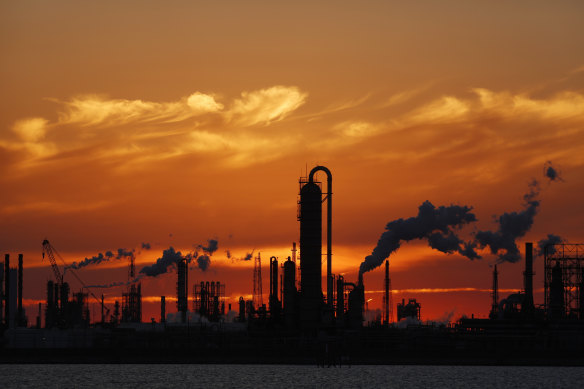By Mike Foley and Nick Toscano
Australia’s window to reach net zero carbon emissions by 2050 is rapidly closing, an international research body warns, unless the Albanese government supercharges the amount of renewable power in the grid by the end of this decade.
Research published on Monday by Bloomberg New Energy Finance calculates the share of wind, solar and hydropower in the electricity grid needs to more than double to 87 per cent by 2030 for the nation to reach its net zero goal.

BloombergNEF says Australia needs to double down and accelerate its decarbonisation efforts in the next decade.Credit: Bloomberg
That is significantly higher than the government’s current target of 82 per cent renewables by 2030, which already risks slipping out of reach due to a slowdown in green investments and delays to key infrastructure needed to connect wind and solar regions to the grid.
“The window for achieving net zero by 2050 is rapidly closing,” BloombergNEF head of Australian research Leonard Quong said.
“The country needs to double down and accelerate its decarbonisation efforts in the next decade, starting immediately, or it risks missing its climate goals.”
To limit global warming as close as possible to 1.5 degrees – the level the Paris Agreement deems necessary to avert the worst effects of climate change – scientists say the world must reach a balance between the emissions it produces and those it removes from the atmosphere, known as “net zero” emissions.
According to figures from the Clean Energy Council, investment in large-scale renewable energy projects fell almost 80 per cent over 2023 due to higher construction costs, supply chain bottlenecks and delayed planning approvals.
The Clean Energy Regulator has said Australia must add at least 7 gigawatts of renewable energy to the grid each year to reach its climate goals, but in 2023 just 5.3 gigawatts came online.
Officials warn the green shift is not happening fast enough to avoid the risk of blackouts and price spikes as nearly every coal-fired power plant shuts in the next decade.
The amount of renewable energy in the grid has increased by 25 per cent since the Albanese government came to power and on average now accounts for 40 per cent of the mix.
Climate Change and Energy Minister Chris Bowen said the government was on track to reach its 2030 climate target but acknowledged more needed to be done for the renewables rollout.
“We must stay the course in implementing our policies. We’ve done a lot, but there’s more to do,” Bowen said.
“This is in sharp contrast to the opposition’s plan which would be catastrophic for any hopes of reaching net zero by 2050.”
The Albanese government estimates policies including its Capacity Investment Scheme – where companies bid to build renewable projects, with their profits underwritten by the Commonwealth – will spur $67 billion in private investment in the grid.
The Paris Agreement requires nations to set increasingly ambitious climate targets every five years. The government has committed to cutting emissions by 43 per cent by 2030 and pledged to set a more ambitious 2035 goal next year.
Opposition Leader Peter Dutton signalled in June that a Coalition government would scrap the 2030 target, stating: “There’s no sense in signing up to targets you don’t have any prospect of achieving”.
This would breach the terms of the Paris Agreement, which the former Abbott government committed to on Australia’s behalf in 2015, along with 190 other countries.
The opposition has announced it would build seven nuclear reactors across the country to replace closing coal plants, with the first reactor to come online by 2035. It has also promised to release plans to increase gas-fired power in the grid.
Opposition energy spokesman Ted O’Brien said wind and solar power would also play a central role but the Coalition would not reveal the proportion of renewables in its plan until a later date.
Cut through the noise of federal politics with news, views and expert analysis. Subscribers can sign up to our weekly Inside Politics newsletter.